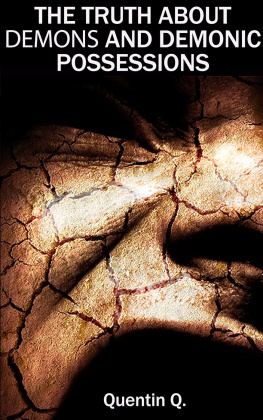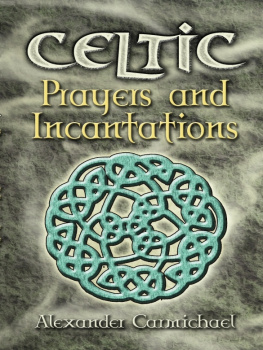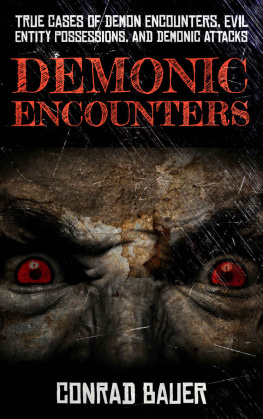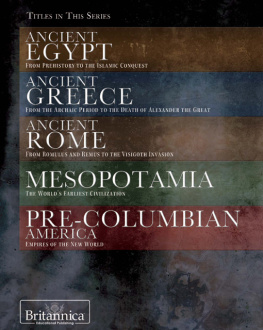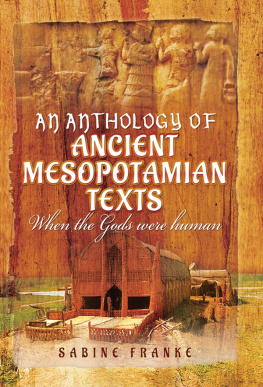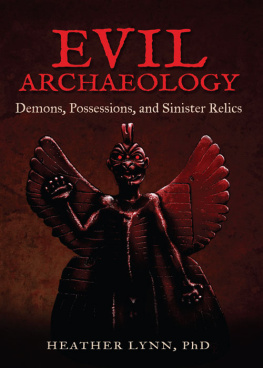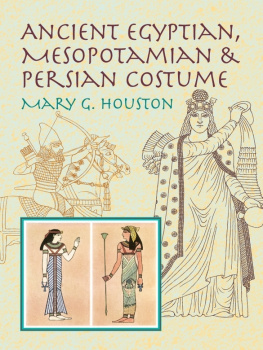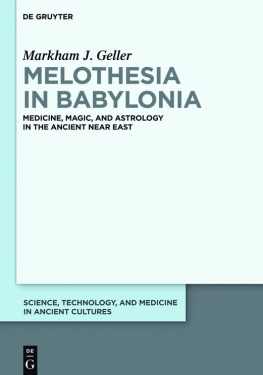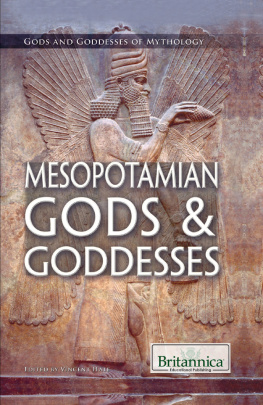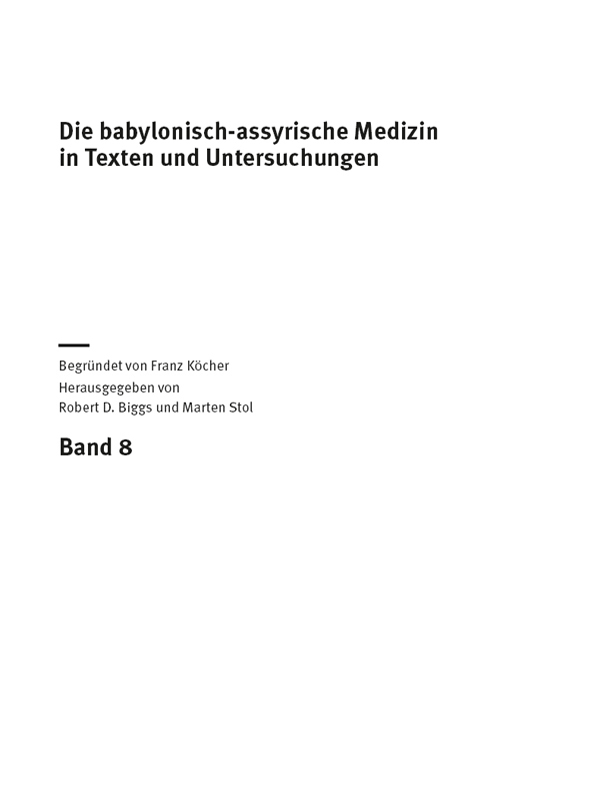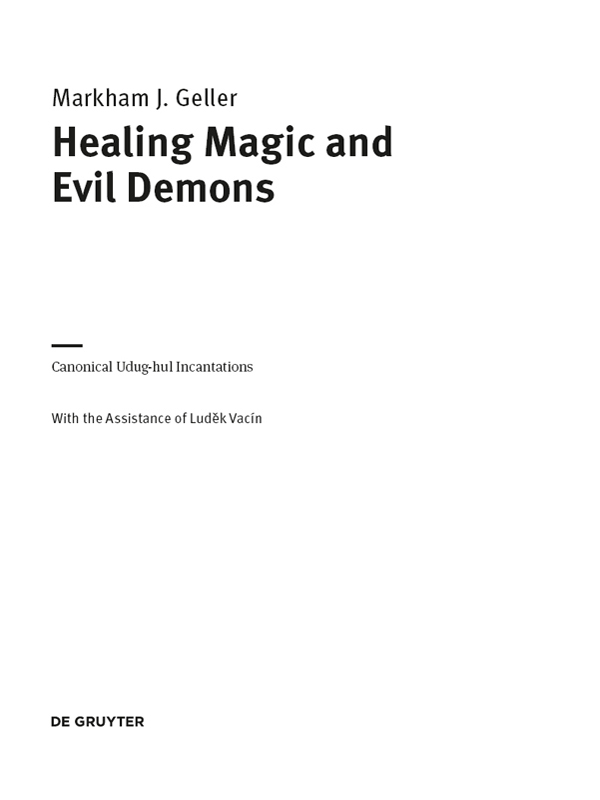Contents
- Chapter One
Healing magic and Udug-hul Incantations - Chapter Two
Survey of Mesopotamian Magic - Chapter Three
Udug-hul as Healing Arts - Chapter Four
Text Partitur of Udug-hul

Markham J. Geller
Healing Magic and Evil Demons
ISBN 978-1-61451-532-6
e-ISBN (PDF) 978-1-61451-309-4
e-ISBN (EPUB) 978-1-5015-0015-2
Library of Congress Cataloging-in-Publication Data
A CIP catalog record for this book has been applied for at the Library of Congress.
Bibliographic information published by the Deutsche Nationalbibliothek
The Deutsche Nationalbibliothek lists this publication in the Deutsche Nationalbibliografie; detailed bibliographic data are available in the Internet at http://dnb.dnb.de.
2016 Walter de Gruyter Inc., Boston/Berlin
www.degruyter.com
Acknowledgements
My very first encounter with the Series Udug-hul occurred in 1974, when D. J. Wiseman sent me off to the Students Room of the British Museum with the number of an unpublished Middle Assyrian incantation tablet. There I first encountered the formidable W. G. Lambert, who immediately opened one of the heavy Rawlinson tomes to show me that editing a single tablet would not do, and that I had to edit all of the tablets in a Series having a specific rubric. What Lambert did not tell me (although he surely knew) was that this would be a life-long endeavor. It is now 40 years since this conversation took place.
My good fortune was having an office at UCL within a stones throw of the British Museum, which I visited on a weekly basis. Aside from Lamberts considerable help (and allowing me access to his invaluable notebooks of transliterations), work on Udug-hul progressed enormously once Irving Finkel arrived from the Oriental Institute to take up his post as Assistant Keeper, with his impressive ability to recognise Udug-hul tablets in the Babylon Collection. At the same time, Erle Leichty allowed me access to his notes while cataloguing the BM Sippar Collection, and Christopher Walker was kind enough to allow me access to the British Museum Geers Copies. Further progress was made possible by generous colleagues visiting the British Museum, such as Rykele Borger, W. Schramm, Walter Farber, J. Fincke, E. Jimnez, and others, as well as colleagues who informed me about tablets in other collections, such as Stefan Maul and Antoine Cavigneaux. In recent years, photographs of tablets from further afield were sent to me by Andrew George, Gianni Marchesi, and Eva Cancik-Kirschbaum.
I was greatly assisted in this work by the staff of various museums, and in particular the British Museums (then) Department of Western Asiatic Antiquities (now Middle East Department), the Vorderasiatisches Museum, Berlin, and the Istanbul Archaeological Museum. The copies of all tablets in this volume are made with the permission of the Trustees of the British Museum, and similar permission was acquired from museums in Berlin and Istanbul. W. G. Lambert was kind enough to collate Sultantepe tablets for me since I was denied permission to work in Ankara.
So much for the textual work on the Series. I was invited to spend an academic year at the Netherlands Institute of Advanced Study (NIAS) in Wassenaar, in a research group on Magic and Religion in the Ancient Near East comprised of Frans Wiggermann, Tzvi Abusch, Karel van der Toorn, Shaul Shaked, and Wim van Binsbergen, and during this period the introduction and commentary to Udug-hul began to take shape, influenced by the discussions within this research group; working with Frans Wiggermann was particularly fruitful. In recent years, attention to explaining the text of Udug-hul was aided by my tenure at the Freie Universitt Berlin (Topoi Excellence Cluster) as Professor fr Wissensgeschichte.
The final editing and correcting of the readings extended over a considerable period, ably assisted by Ludk Vacn, who was Wissenschaftlicher Mitarbeiter for the DFG-NEH (Deutsche Forschungsgemeinschaft and National Endowment for the Humanities) project Bilinguals in Late Mesopotamian Scholarship (in conjunction with Steve Tinney). Ludk read through every line of every manuscript with me and made useful corrections, as well as mounting the plates and contributing a copy of his own. The DFG has also contributed to the publication costs of this volume. Special thanks are also due to Andrew George for allowing me to include W. G. Lambert's edition of Marduk's Address to the Demons .
The editors of the BAM series, Robert Biggs and Marten Stol, provided extensive comments and criticism, for which I am extremely grateful. Technical assistance was also supplied by Jana Schmalfu and Marie Lorenz. The staff of W. de Gruyter have been helpful, as always, in bringing the volume to press.
Last but not least, my assessment of Udug-hul has altered over the years. While working on the Sumerian forerunner to these incantations, I viewed the Series as representative of Sumerian belles lettres . The last stage of work on Udug-hul has been carried out during the initial stages of the ERC Project BabMed , and the resulting intensive work on Babylonian medicine has led to a completely different assessment of Udug-hul as healing incantations, intended specifically for patients. For this reason, this edition of the Udug-hul canonised text has been included within the series Babylonischassyrische Medizin , as an example of the complementary nature of Mesopotamian Heilkunde consisting of theoretical and practical approaches found within both magic and medicine.
Berlin 2015
Chapter One
Healing magic and Udug-hul Incantations
The bilingual incantations, known in Sumerian as Udug-hul-a-kam and in Akkadian as Utukk Lemntu (Incantations of) Evil Demons (hereafter UH), are attested among the very earliest of Mesopotamian incantations from the third millennium BCE down to the very latest cuneiform tablets with Greek transliterations. The original text consisted of a collection of Sumerian unilingual spells which were later edited into a much larger and mostly bilingual (Sumerian-Akkadian) incantation Series, although also containing substantial and lengthy Akkadian unilingual compositions without Sumerian precursors. It will be demonstrated below that one main purpose of UH incantations was to treat patients for illnesses borne by demons, rather than for more general types of misfortune.
History of the present text edition
A text edition and translation of UH was first published by R. Campbell Thompson in 1904 under the provocative title, The Devils and Evil Spirits of Babylonia , and to his credit, the book is still being reprinted and remains of value, partly because a number of texts in this two-volume work have never been re-edited or retranslated. In fact, the first publication of UH incantations in cuneiform copies dates back to the earliest days of Assyriology, when a steady stream of tablets from the Near East were arriving in the British Museum. The British Museum UH tablets were the first of this bilingual genre to be published, in 1875.
Campbell Thompsons Devils and Evil Spirits appeared a year after the publication of the autograph copies of the tablets, in Cuneiform Tablets in the British Museum vol. 16 and 1 7, which provided a wealth of new Sumerian Akkadian exorcistic incantations, with most of the known UH incantations appearing in CT 16. The problem with Campbell Thompsons otherwise pioneering work, however, is that he combined the copies of various cuneiform sources into a single autograph copy, without regard as to whether individual cuneiform manuscripts were in Assyrian or Babylonian script, and his apparatus criticus was woefully inadequate. The actual characteristics of any individual manuscript were usually obscured by this method, which was adapted from Classical scholarship.



